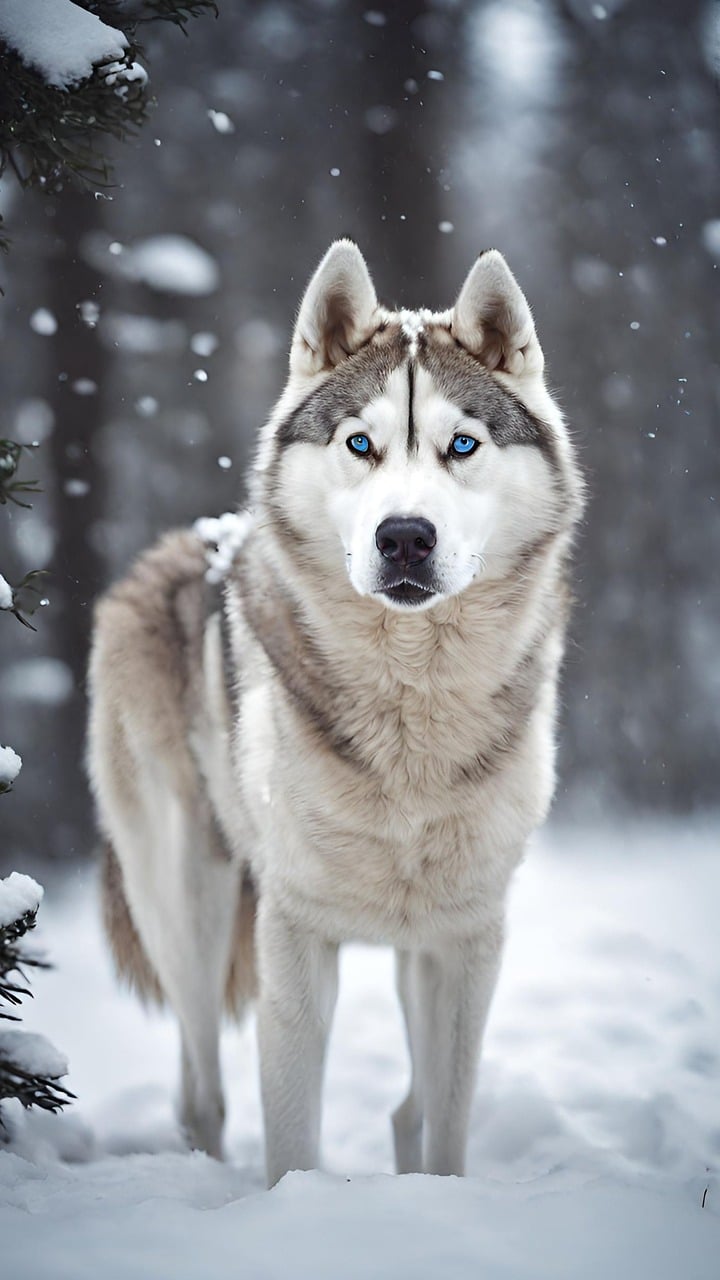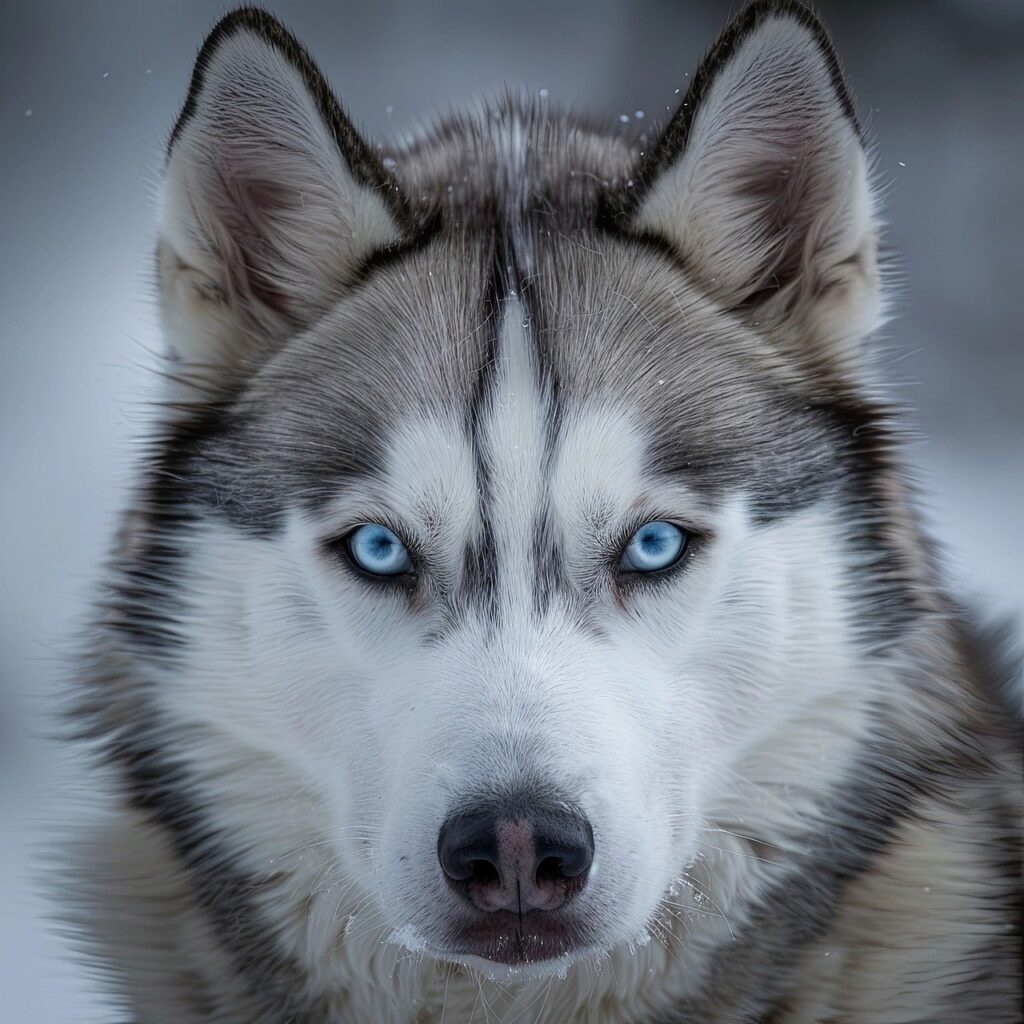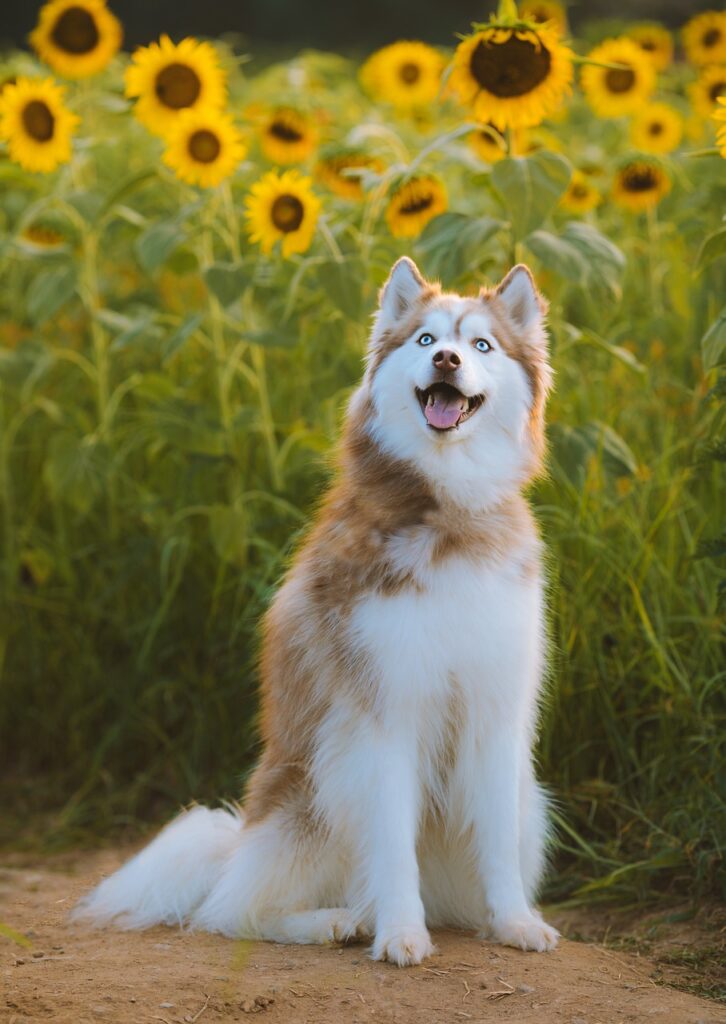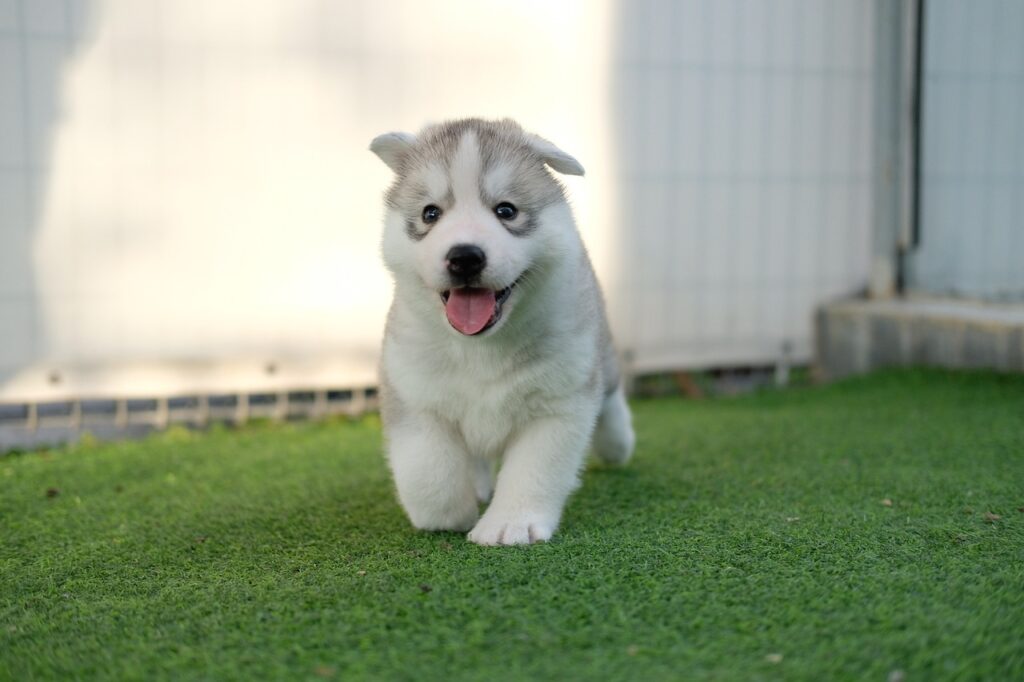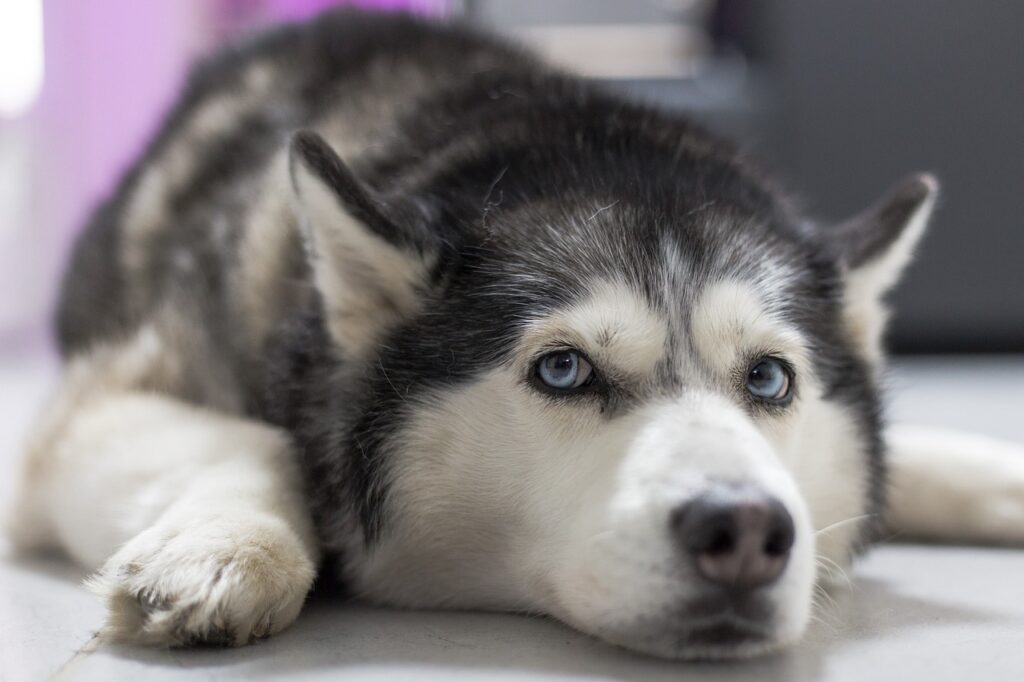The Husky, commonly referred to as the Siberian Husky is a medium-sized working dog breed known for its striking appearance and friendly temperament. Here are some key characteristics:
Origin
- Background: Originally bred by the Chukchi people in Siberia, they were used for sled pulling and as companion animals.
Physical Traits
- Appearance: Huskies have a thick double coat that can come in various colors, striking blue or multi-colored eyes, erect triangular ears, and a bushy tail that often curls over the back.
- Size: Typically weigh between 35 to 60 pounds (16 to 27 kg) and stand about 20 to 24 inches (51 to 61 cm) tall at the shoulder.
Temperament
- Friendly: Known for their sociable and outgoing nature, Huskies are generally good with families and children.
- Energetic: They have high energy levels and require regular exercise and mental stimulation to stay happy.
Intelligence
- Clever: Huskies are intelligent but can be independent and stubborn, which may make training a bit challenging.
Care Requirements
- Exercise: They need plenty of physical activity, including long walks, runs, and playtime.
- Grooming: Regular grooming is necessary due to their thick coat, especially during shedding seasons.
Overall, Siberian Huskies are known for their beauty, loyalty, and playful nature, making them beloved companions for active families!
Siberian Huskies don’t have distinct “types” in the same way some breeds do, but they can be categorized based on certain traits, purposes, and breeding lines. Here are a few common distinctions:
1. Show Line Huskies
- Purpose: Bred primarily for conformation shows and adherence to breed standards.
- Traits: These Huskies may have features that conform closely to breed standards, such as specific coat colors and body structure.
- Temperament: Generally calm and well-adjusted, but they may not have the same high energy as working lines.
2. Working Line Huskies
- Purpose: Bred for strength and stamina for sledding and other physical tasks.
- Traits: Typically leaner and more athletic, these Huskies are bred for performance rather than appearance.
- Temperament: Often more energetic and driven, they require significant exercise and mental stimulation.
3. Alaskan Huskies
- Background: Not a distinct breed, but a mix of various breeds including Siberian Huskies, bred for specific traits desirable in sled dogs.
- Traits: Generally varied in appearance and can be any combination of sizes and colors. They are primarily bred for their ability to perform in racing and work conditions.
4. Pet Quality Huskies
- Purpose: Bred primarily for companionship rather than for shows or working.
- Traits: May not adhere strictly to breed standards but are typically friendly and healthy.
- Temperament: Can vary widely, but they usually have a playful and loving disposition.
While these categories can help understand the different types of Huskies, all Siberian Huskies share common traits of intelligence, friendliness, and high energy levels. They thrive in active environments!
Siberian Huskies are available in a wide range of coat colors and patterns. Here are some of the most common colors:
1. Black and White
- A classic combination with a predominantly black coat and white markings, including the face, paws, and belly.
2. Gray and White
- This can range from light gray to deep charcoal, often with white facial markings and accents.
3. Red and White
- A striking color that can vary from copper-red to a lighter, almost blonde shade, typically with white markings.
4. Agouti
- A wild-looking color that consists of a mix of gray, brown, and black hairs, often giving a “wolf-like” appearance.
5. Sable
- A color pattern that features a light base coat with darker-tipped hairs. This can appear in various shades, often combined with white markings.
6. White
- Some Huskies are completely white, though this is less common. They can have blue eyes, brown eyes, or even one of each.
7. Piebald or Patterned
- Huskies can also have various patterns, including patches of color over a white base coat. These patterns can include combinations of any of the above colors.
Eye Colors
In addition to coat colors, Huskies are known for their striking eye colors, which can be:
- Blue
- Brown
- One blue and one brown (heterochromia)
These variations contribute to the breed’s unique and captivating appearance!
Training a Siberian Husky can be rewarding but requires patience, consistency, and understanding of their unique traits. Here are some effective strategies:
1. Start Early
- Begin training as a puppy to establish good habits and socialization early on.
2. Use Positive Reinforcement
- Reward good behavior with treats, praise, or playtime. This encourages your Husky to repeat those behaviors.
3. Keep Sessions Short and Engaging
- Limit training sessions to 5-15 minutes to maintain their focus. Make it fun with games and rewards.
4. Be Consistent
- Use the same commands and cues each time. Consistency helps them learn faster.
5. Socialization
- Expose your Husky to different people, pets, and environments. This helps reduce fearfulness and enhances their social skills.
6. Basic Commands
- Teach essential commands like “sit,” “stay,” “come,” and “down.” These commands form the foundation for further training.
7. Leash Training
- Practice walking on a leash to prevent pulling. Use treats to encourage them to walk beside you.
8. Mental Stimulation
- Huskies are intelligent and need mental challenges. Use puzzle toys, training games, and agility exercises to keep them engaged.
9. Impulse Control
- Teach your Husky to wait for cues before eating or playing. This helps with self-control.
10. Be Patient and Adapt
- Huskies can be independent and sometimes stubborn. If they don’t respond immediately, stay calm and try again later.
11. Avoid Negative Reinforcement
- Focus on positive methods rather than punishment. Harsh training can lead to fear or resistance.
12. Seek Professional Help if Needed
- If you encounter challenges, consider enrolling in a training class or consulting a professional trainer.
With dedication and understanding, your Siberian Husky can become a well-trained and happy companion!
Caring for a Siberian Husky involves attention to their health, nutrition, exercise, grooming, and overall well-being. Here are some key aspects to consider:
Health
- Regular Veterinary Checkups
- Schedule annual health exams and keep up with vaccinations to monitor overall health.
- Common Health Issues
- Be aware of breed-specific concerns, including:
- Hip dysplasia
- Eye problems (such as cataracts and progressive retinal atrophy)
- Skin conditions
- Be aware of breed-specific concerns, including:
- Dental Care
- Brush your Husky’s teeth regularly to prevent dental issues and maintain good oral hygiene.
- Preventative Medications
- Keep your dog on flea, tick, and heartworm prevention as recommended by your veterinarian.
Nutrition
- Balanced Diet
- Feed high-quality dog food appropriate for your Husky’s age, size, and activity level. Consult your vet for recommendations.
- Portion Control
- Monitor portion sizes to prevent obesity. Huskies have a tendency to gain weight if overfed.
- Hydration
- Ensure your Husky has access to fresh water at all times, especially after exercise.
Exercise
- Daily Activity
- Huskies are energetic dogs that need ample exercise. Aim for at least 1-2 hours of physical activity each day, including walks, runs, and playtime.
- Mental Stimulation
- Provide mental challenges through training, puzzle toys, and interactive games to keep them engaged.
Grooming
- Regular Brushing
- Brush your Husky’s thick double coat at least once a week to reduce shedding and keep it healthy. During the shedding season (spring and fall), more frequent brushing may be necessary.
- Bathing
- Bathe your Husky as needed, typically every few months or when they get particularly dirty.
- Nail Trimming
- Regularly trim your dog’s nails to avoid overgrowth and ensure comfort.
- Ear Cleaning
- Check and clean your Husky’s ears regularly to prevent infections, especially if they are prone to ear issues.
Training and Socialization
- Ongoing Training
- Reinforce basic commands and good behavior throughout their life. Regular training sessions help keep them mentally stimulated.
- Socialization
- Expose your Husky to various environments, people, and other animals to help them develop good social skills.
By focusing on these aspects, you can help ensure that your Siberian Husky remains healthy, happy, and well-adjusted!

